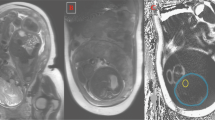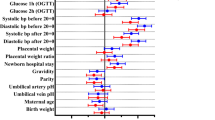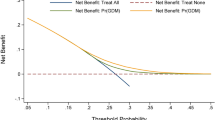Abstract
Objective:
The objective of this study is to evaluate third-trimester fetal liver biometry, to predict birth weight and cord markers at birth in diabetic pregnancies.
Study Design:
Fetal liver biometry (liver diameters, area and volume) was obtained between 32 and 34 weeks. A blood sample was obtained from cord after birth. Receiver operating characteristic (ROC) curve models were evaluated for 75th and 90th birth weight percentile. Univariate and multivariate models were used.
Result:
All the hepatic diameters, area and sectional volume demonstrated significant differences in both birth weight percentile ⩾75 and ⩾90. All ROC curves showed significant values. A significant association was observed for all measurements with birth weight. In multivariate model, liver area volume gave significant values for predicting birth weight. Cord leptin, c-peptide and ferritin were related to fetal hepatic size.
Conclusion:
The hepatic changes in gestational diabetes were valid to predict birth weight and metabolic changes at birth.
This is a preview of subscription content, access via your institution
Access options
Subscribe to this journal
Receive 12 print issues and online access
$259.00 per year
only $21.58 per issue
Buy this article
- Purchase on Springer Link
- Instant access to full article PDF
Prices may be subject to local taxes which are calculated during checkout

Similar content being viewed by others
References
Nyberg DA, Abuhamad A, Ville Y . Ultrasound assessment of abnormal fetal growth. Semin Perinatol 2004; 28 (1): 3–22.
Tongprasert F, Srisupundit K, Luewan S, Tongsong T . Normal length of the fetal liver from 14 to 40 weeks of gestational age. J Clin Ultrasound 2011; 39 (2): 74–77.
Perovic M, Gojnic M, Arsic B, Pantic I, Stefanovic T, Kovacevic G et al. Relationship between mid-trimester ultrasound fetal liver length measurements and gestational diabetes mellitus. J Diabetes 2015; 7 (4): 497–505.
Gojnic M, Stefanovic T, Perovic M, Arsic B, Garalejic E, Micic J et al. Prediction of fetal macrosomia with ultrasound parameters and maternal glycemic controls in gestational diabetes mellitus. Clin Exp Obstet Gynecol 2012; 39 (4): 512–515.
Anderson NG, Notley E, Graham P, McEwing R . Reproducibility of sonographic assessment of fetal liver length in diabetic pregnancies. Ultrasound Obstet Gynecol 2008; 31 (5): 529–534.
Chang FM, Hsu KF, Ko HC, Yao BL, Chang CH, Yu CH et al. Three-dimensional ultrasound assessment of fetal liver volume in normal pregnancy: a comparison of reproducibility with two-dimensional ultrasound and a search for a volume constant. Ultrasound Med Biol 1997; 23 (3): 381–389.
Dos Santos Rizzi MC, Araujo Júnior E, Nardozza LM, Diniz AL, Rolo LC, Moron AF . Nomogram of fetal liver volume by three-dimensional ultrasonography at 27 to 38 weeks of pregnancy using a new multiplanar technique. Am J Perinatol 2010; 27 (8): 641–648.
Dubé MC, Girard M, Morisset AS, Tchernof A, Weisnagel SJ, Bujold E . Evaluation of fetal liver volume by tridimensional ultrasound in women with gestational diabetes mellitus. J Obstet Gynaecol Can 2011; 33 (11): 1095–1098.
Boito SM, Struijk PC, Ursem NT, Stijnen T, Wladimiroff JW . Assessment of fetal liver volume and umbilical venous volume flow in pregnancies complicated by insulin-dependent diabetes mellitus. BJOG 2003; 110 (11): 1007–1013.
Garcia-Flores J, Cruceyra M, Cañamares M, Garicano A, Nieto O, Lopez A et al. Fetal limb soft tissue assessment for prediction of birth weight and umbilical cord blood analytes in gestational diabetes. Prenat Diagn 2015; 35: 1187–1196.
Fonseca MJ, Santos AC . Umbilical cord blood adipokines and newborn weight change. Arch Gynecol Obstet 2014; 291: 1037–1040.
Josefson JL, Zeiss DM, Rademaker AW, Metzger BE . Maternal leptin predicts adiposity of the neonate. Horm Res Paediatr 2014; 81 (1): 13–19.
Jahan S, Zinnat R, Hassan Z, Biswas KB, Habib SH . Gender differences in serum leptin concentrations from umbilical cord blood of newborn infants born to nondiabetic, gestational diabetic and type-2 diabetic mothers. Int J Diabetes Dev Ctries 2009; 29 (4): 155–158.
Dubé MC, Morisset AS, Tchernof A, Weisnagel SJ . Cord blood C-peptide levels relate to the metabolic profile of women with and without gestational diabetes. Acta Obstet Gynecol Scand 2012; 91 (12): 1469–1473.
Teramo KA, Widness JA . Increased fetal plasma and amniotic fluid erythropoietin concentrations: markers of intrauterine hypoxia. Neonatology 2009; 95 (2): 105–116.
Classification and diagnosis of diabetes mellitus and other categories of glucose intolerance. National Diabetes Data Group. Diabetes 1979; 28: 1039–1057.
Spanish Society of Gynecology and Obstetrics (Perinatal Medicine Section) Spanish Tables for Neonatal Weight by Gestational Age. Laboratorios Menarini: Madrid, Spain, 1998.
Snijders RJ, Nicolaides KH . Fetal biometry at 14-40 weeks' gestation. Ultrasound Obstet Gynecol 1994; 4 (1): 34–48.
Szpinda M, Paruszewska-Achtel M, Woźniak A, Badura M, Mila-Kierzenkowska C, Wiśniewski M . Three-dimensional growth dynamics of the liver in the human fetus. Surg Radiol Anat 2015; 37 (5): 439–448.
Al-Badri MR, Zantout MS, Azar ST . The role of adipokines in gestational diabetes mellitus. Ther Adv Endocrinol Metab 2015; 6 (3): 103–108.
Acknowledgements
We gratefully acknowledge Israel J Thuissard for expert technical assistance. We thank Cristina Criado, Maria Caballero and all the nursing staff on the Labor and Delivery Unit, who were responsible for the management of the umbilical cord sample for the present study. We also thank all the Obstetrics and Gynecology Department and Clinical Analysis Department staff for their helpful collaboration. This study was funded by grants by Fundación Mutua Madrileña (grant number AP105302012) and Fundación Universidad Europea de Madrid (grant number 2013/UEM22). The funders had no role in study design, data collection and analysis, decision to publish, or preparation of the manuscript.
Author information
Authors and Affiliations
Corresponding author
Ethics declarations
Competing interests
The authors declare no other conflicts of interest.
Rights and permissions
About this article
Cite this article
Garcia-Flores, J., Cruceyra, M., Cañamares, M. et al. Predictive value of fetal hepatic biometry for birth weight and cord blood markers in gestational diabetes. J Perinatol 36, 723–728 (2016). https://doi.org/10.1038/jp.2016.72
Received:
Revised:
Accepted:
Published:
Issue Date:
DOI: https://doi.org/10.1038/jp.2016.72



